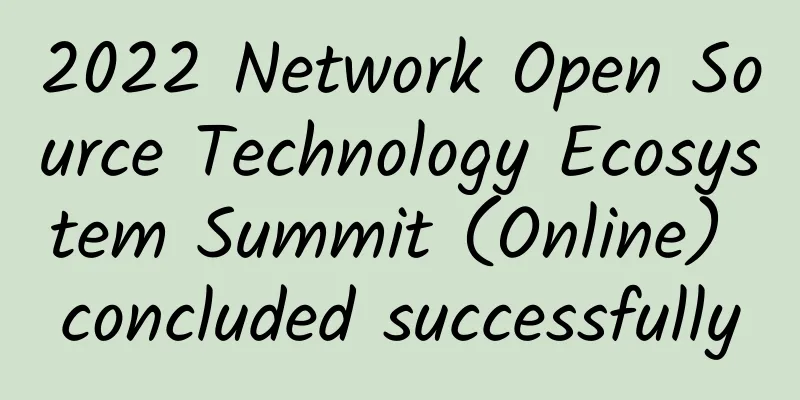2022 Network Open Source Technology Ecosystem Summit (Online) concluded successfully

|
From May 24 to May 26, the 2022 Network Open Source Technology Ecosystem Summit (online) was successfully held. This conference was guided by the "Science and Technology Innovation China" Future Network Professional Technology Service Group, hosted by the Jiangsu Future Network Innovation Research Institute, and undertaken by the SDNLAB community. The conference has a main forum and 5 sub-forums. 51 guests from 30 units discussed and exchanged ideas on topics such as P4 technology and applications, network optimization acceleration and intelligent scheduling, SONiC technology and applications, cloud native networks and open source governance, and edge computing technology and applications. The conference attracted more than 50,000 online viewers. The main forum was attended by many celebritiesAt the main forum on the 24th, Liu Yunjie, academician of the Chinese Academy of Engineering, dean of Jiangsu Future Network Innovation Research Institute, and director of Purple Mountain Laboratory of Network Communication and Security, Duan Xiaodong, deputy director of China Mobile Research Institute, Tang Xiongyan, deputy director and chief scientist of China Unicom Research Institute, Zou Ting, Arm enterprise architect and chairman of the board of directors of LF Edge, Jing Youhao, CTO of Juniper China, Chen Wei, director of edge and IoT technology of Tencent, and Wang Qing, director of cloud infrastructure software R&D of Intel Software and Advanced Technology Group attended and delivered keynote speeches. Liu Yunjie gave a keynote speech entitled "Promoting Future Network Innovation and Boosting the Development of the Internet in the Second Half". Liu Yunjie pointed out that the Internet has achieved great success in the consumer field, and will face great challenges in the production field. The traditional IP network architecture of "doing its best" is no longer applicable, and the network needs to have the ability to determine the quality of service. Deterministic, programmable, cloud-based, and integrated security have become important development trends for future networks. In the future, network capabilities will be comprehensively improved in terms of carrying, control, and business. The Future Network Innovation Experimental Environment (CENI) can provide a basic environment for the innovation of future networks and 5G/B5G related technologies, and serve major demand scenarios such as the Industrial Internet, the Computing Internet, and the Space Internet. Duan Xiaodong gave a keynote speech entitled "Discussion on the open source ecosystem for "connection + computing power + capability"". Duan Xiaodong said that today is the era of digital economy, and computing power has become the cornerstone of the digital transformation of the whole society. "Connection + computing power + capability" is becoming the basis for China Mobile to build information services in the next step. Duan Xiaodong proposed that in the future, we should move from cloud to computing, promote multi-cloud collaboration and edge cloud integration and unification, realize unified scheduling and collaborative management for pan-computing, and accelerate the construction of a distributed computing power open source system. Realize network-based computing, optimize network architecture and collaborative scheduling open source capabilities, and build an all-reaching intelligent network. Tang Xiongyan gave a keynote speech entitled "Thoughts and Practices on Network Openness and Open Source". Tang Xiongyan said that in the future, an end-to-end open network needs to be built, and network equipment and network management must be open at every level, from wireless access, core network, bearer network to underlying optical transmission. Network openness and open source is a long-term process, and promoting network openness is an important direction for network transformation. From CUBE-Net2.0 to CUBE-Net3.0, China Unicom has been adhering to the technical concept of open network and continuously advancing it. In the future, it will also need to pay more attention to challenges in technology innovation, capability opening, business transformation, and ecological construction. Chen Wei delivered a keynote speech titled "Evolution and Exploration of Tencent's Edge Internet Network Technology". Chen Wei pointed out that distributed cloud, 5G, and the Internet of Things have become important development directions in the future and will become important infrastructure for computing and networking. Tencent Cloud Infrastructure helps customers provide public cloud, private cloud, proprietary cloud, and hybrid cloud services with a unified technology stack and product experience. In addition, Tencent has also been continuously exploring and innovating in many aspects such as edge interconnection and accelerated network technology, high-performance network technology, and 5G edge computing. In addition, Arm enterprise architect and LF Edge board chairman Zou Ting, Juniper China CTO Jing Youhao, and Intel Software and Advanced Technology Group Cloud Infrastructure Software R&D Director Wang Qing also delivered keynote speeches on "LF Edge in China", "Technology Outlook for Building Future Networks", and "Intel's Service Mesh Technology" respectively. P4 Technology and ApplicationAt the P4 Technology and Application Forum, guests from Zhiqi, Intel, JD.com, Alibaba, Baidu, China Mobile, Beijing University of Posts and Telecommunications, and Shenzhen Hengyang also gave wonderful speeches and conducted in-depth sharing and exchanges on topics such as P4-assisted programmability, programmable network platforms, and hardware and software integration. Zheng Minxian, technical manager of Zhiqi Open Network, delivered a keynote speech entitled "Zhiqi's Road to White Box Switches". In the past decade, the open network industry has continued to grow, and the three major network open source organizations ONF, OCP, and TIP have been established one after another. At the same time, many start-ups dedicated to promoting innovation in the network industry have emerged, and the open network ecosystem has grown more and more innovative scenarios and applications. Zhiqi Communications launched the P4 white box switch based on Tofino2 and the ServierSwitch white box computing platform based on Tofino, providing a fertile ground for innovation in the industry. Kang Haitao, technical director of Intel's Barefoot Division, shared a keynote speech titled "P4 and IPDK Empower Programmable Networks." Kang Haitao focused on some of Intel's innovations based on P4 and IPDK. The main goal of the P4 network protocol stack PINS is to bring SDN and P4-based programmability to the SONiC network operating system. IPDK is an open source, vendor-independent driver and API framework that manages infrastructure built by CPUs, IPUs, DPUs, or switches. The hyper-converged programmable network platform integrates Server and Switch, on which you can run IPDK or PINS/SONiC. It is highly flexible and can be applied to scenarios such as computing power networks, cloud-network convergence, and edge computing. Alibaba technical expert and Harvard University Ph.D. Gao Jiaqi introduced "Taixuan: Alibaba Cloud's self-developed programmable network compilation platform". Gao Jiaqi said that the current programmable network development is still in its infancy, and there are still various problems in the development, optimization and testing links, resulting in low development efficiency. During the development phase, Alibaba Cloud's self-developed Taixuan programmable network compilation platform solved the three core problems of portability, scalability and composability in the process of developing programmable network programs through language generators, coding chip resources and code arrangement. At the same time, it also solved the pain points of programmable network optimization such as resource matching and dependency chain length, improving the work efficiency of developers, allowing programmable networks to iterate quickly, thereby improving the service quality of the network. Wang Peilong, head of Baidu Smart Cloud IaaS network, shared Baidu Cloud's programmable hardware practices in the field of cloud computing networks. With the acceleration of digital transformation and intelligent upgrades, more enterprise-level applications have begun to be built based on new models such as multi-cloud, hybrid cloud, and edge cloud, which has put higher requirements on the network and also created a series of challenges for cloud networks. Wang Peilong introduced that Baidu Cloud has fully applied the evolution of the integrated hardware and software architecture of programmable hardware + general software collaboration, as well as NFV to increase elastic expansion and contraction capabilities and SFC to increase network service link programmability capabilities to dedicated line gateways, cloud intelligent networks CSN, peer connections, elastic public network IP, flow logs, edge computing, local computing clusters LCC and other products, and is committed to building a reliable, high-speed, and intelligent cloud network to make cloud access easier. In addition, Dong Yun, network architect of JD Technology's JD Cloud Business Group, Cheng Weiqiang, chief researcher at China Mobile Research Institute, Liu Jiang, professor at Beijing University of Posts and Telecommunications, and Li Haojie, director of Shenzhen Hengyang Data's programmable network product line, also delivered keynote speeches on "Practice of P4 Programmable Converged Gateway in Edge Data Center", "G-SRv6 Routing System and Networking Test Based on P4", and "Practice of P4 Chip-Level In-band Telemetry Technology". Network optimization acceleration and intelligent schedulingAt the sub-forum on network optimization, acceleration and intelligent scheduling, guests from Intel, Purple Mountain Laboratory, Yeepay, and ChipQR gave wonderful reports on network optimization, acceleration, intelligent scheduling, load balancing, and programmable network cards. Ma Jianwei and Chang Hao, senior engineers from Intel's Network Platform Division, delivered a keynote speech titled "Application Practice of Intel TADK in 5G UPF DPI". In response to the challenges faced by application identification of 5GC UPF DPI in the current complex network environment, they introduced the TADK high-performance traffic analysis development kit based on the AI capabilities of the IA platform and the training and reasoning process based on AI/ML. In combination with real application scenarios, they shared the detailed practices of Intel and its ecosystem partners in applying TADK to 5G UPF, including application identification accuracy and performance test data. Hu Kan, Product Marketing Director of Xinqiyuan, gave a keynote speech titled "Xinqiyuan provides core power for open networks". Hu Kan pointed out that DPU is the inevitable result of business development driving technological progress. The development of cloud computing, 5G, big data, artificial intelligence and even the metaverse has promoted the development of a data center-centric system, and DPU came into being. Xinqiyuan has created a full-ecosystem solution based on DPU, and will make deeper expansion in a wider range of industries and fields in the future, while continuing to provide core capabilities for open networks. In addition, Intel senior software engineers Zhang Fan, Liu Yong, and Pei Yulong, Purple Mountain Laboratory researcher Zheng Zhi, Yeebao Payment Operation and Maintenance Director Lu Wanlong, and Intel senior network software engineer Wang Xiao also delivered keynote speeches on "Typical Applications of Intel Accelerator-Enabled VPP", "Exploration and Practice of Network Operating System Open Source Technology", "Thinking and Evolution of Next-Generation Load Balancing Products", and "End-to-End Analysis of Network Tunnels and Performance Optimization Based on Programmable Network Cards". SONiC Technology and ApplicationAt the SONiC Technology and Application Forum, more than 10 representatives from Keysight, Alibaba, Tencent, China Telecom, China Unicom, Purple Mountain Laboratory and other companies gave wonderful speeches. The topics covered open network equipment based on SONiC architecture, programmable gateway operating systems, programmable data plane open source development trends and explorations, and other directions. Keysight Sr. Director Business Development Nitesh Jha and Product Manager, Cloud IST Manodipto Ghose delivered a keynote speech entitled "Keysight and SONiC". Starting from the challenges encountered in SONiC testing, the current solutions from SONiC community testbed to customized testing were introduced. In the face of challenges, Keysight has launched two new solutions: 1. Testbed in a box: using 1U-sized UHD devices to allow customers to achieve plug-and-play of community test cases; 2. Open NOS validation suit: providing a one-stop solution for SONiC full-stage testing from scale, function to Day2. Finally, the uniqueness and advantages of Keysight in the field of SONiC testing and in comparison with open source tools were summarized. Yin Chuan, product manager of the Network Capability R&D Center of China Telecom Research Institute, shared the innovative practices of China Telecom's self-developed white box routers. Yin Chuan pointed out that the existing SONiC cannot meet the needs of white box routers. China Telecom has developed a new generation of network operating system C3NOS based on the SONiC open source architecture. C3NOS deeply optimizes the functional modules of SONiC, creates a multi-service universal network element platform, and adds innovative functions and performance improvements that are closer to the network needs of operators. Liu Ying, an engineer from China Unicom Research Institute, delivered a keynote speech titled "Open Network Convergence Equipment Based on SONiC Architecture". Liu Ying said that traditional network equipment usually uses a tightly coupled dedicated network operating system, and telecom equipment cannot quickly utilize the latest developments in IT technology, resulting in slow network innovation. Based on the SONiC architecture, a unified abstract layer definition and development of physical chips is carried out, and open source network operating systems are adapted to existing modular hardware products. China Unicom is committed to expanding modular thinking and creating open network convergence equipment. In addition, Alibaba senior technical experts Zhu Fangbo, Li Hua, Tencent senior technical expert Zhang Qingxin, Beijing University of Posts and Telecommunications lecturer and Purple Mountain Laboratory project leader Wang Shuo, Kuaishou senior R&D engineer Liu Rui, Maipu Communication Technology Co., Ltd. data center chief architect Zhang Huahong, and Cisco Greater China chief architect Jiang Xing also delivered keynote speeches on "Progress of White Box Project S³IP and Introduction to S³IP PIT System", "Introduction to Network Standardization Sysfs", "Development Trend and Exploration of Programmable Data Plane Open Source", "Operating System Design of Programmable Gateway Based on SONiC", "Maipu Open Source Open Ecosystem Exploration", and "Innovation and Practice of Cisco Open Network". Cloud Native Networking and Open Source GovernanceAt the Cloud Native Network and Open Source Governance Sub-Forum, guests from Mulan Open Source Community, ZTE, Tencent, eBay, and Lingqiao Cloud shared their views and practical experiences on the development trends of cloud native networks and cloud native security. Meng Wei, Director of Standards and Open Source Planning at ZTE, delivered a keynote speech on "The Way to Integrate Standards and Open Source". Meng Wei first discussed the relationship between standards and open source. The essential purpose of standards and open source is to form a unified ecosystem based on this technology, but the methods and forms are different, and the ultimate goal is the same. Then he used some cases to show how to integrate standards and open source in 5G networks and artificial intelligence. Meng Wei said that open source and standards should promote each other and define "just right" standards. Liu Mengxin, senior R&D engineer of Lingqiao Cloud and author of Kube-OVN, introduced the "Development Trends of Cloud Native Networks". Cloud native continues to enter more fields, and network capabilities are constantly facing new challenges in terms of traffic orchestration, performance, security, monitoring, and visualization analysis. Liu Mengxin pointed out that a single CNI is difficult to meet the needs of all scenarios. Specific network plug-ins will appear in different scenarios, and network auxiliary components that do not rely on specific CNIs will continue to emerge. The combination of software and hardware will bring cloud native networks to a new battlefield. Geng Hang, head of operations of Mulan Open Source Community & TOC of NextArch Foundation, Zhang Junwei, technical expert of TEG-Cloud Architecture Platform, Chen Youxiong, software engineer of eBay, and Yang Jun, system architect of ZTE, also delivered keynote speeches on "Challenges and Opportunities of Heterogeneous Scenarios in the Process of Enterprise Digital Transformation", "EIP Programmable Switch Gateway", "Production Practice of eBay's Application Gateway Based on Istio", and "Building Hexagonal Warriors-Building Cloud Native Security". Edge computing technology and applicationsAt the edge computing technology and application sub-forum, many representatives from companies such as Cuichu Network, Ailing Network, Huawei, and Jiuzhou Cloud gave wonderful speeches on topics such as cloud-edge collaboration and computing network evolution, 5G edge intelligence, 5G MEC, and integrated edge computing networks based on cloud native and blockchain technologies. Wang Xiaofei, professor and doctoral supervisor at Tianjin University and chief scientist of PPIO, brought a speech titled "Cloud-edge collaboration and computing network evolution". Wang Xiaofei said that in order to achieve "single intelligence" to "cloud-edge-end collaboration and ubiquitous socialized intelligence" from the perspective of scientific research, it is necessary to split "intelligence" from the perspective of the three elements of productivity (production tools, productivity, and means of production) in the 5G intelligent era, focusing on data collaboration, algorithm collaboration, computing power collaboration, and network collaboration. Wang Xiaofei also introduced representative achievements, academic contributions, scientific research results and other related content. Liu Hui, a researcher of edge intelligence technology at Purple Mountain Laboratory of Network Communication and Security, shared his speech "Discussion on Integrated Edge Computing Network Based on Cloud Native and Blockchain Technology". Liu Hui pointed out that edge computing has been developed in the fields of smart manufacturing, smart driving, and smart cities. However, some industrial and technological confusions have also emerged. The field of edge computing is developing towards fragmentation. In the future, it is necessary to create an open and interoperable edge computing framework to break the deadlock of the industrial ecology and promote the development of edge computing. Yu Yifan, CTO of Ailing Network, Chen Daoqing, Operation Director of OSDT Open Source Community of Huawei Cloud Network, Zhang Lei, R&D Director of Jiuzhou Cloud, and Yang Hongyu, SDN R&D Engineer, Huang Jiyong, Edge Computing Architect of EMQ, Zhao Qianli, Software Development Engineer of Intel NPG Cloud, and Bian Junyu, System Software Development Engineer of NPG, and Du Bing, CTO of Future IoT, also delivered keynote speeches on "5G Edge Intelligence Assists the Construction of Digital Workshops", "Introduction and Application Practice of 5G MEC Open Source Platform EdgeGallery", "Cloud-Network Integration Gives New Energy to Openstack", "Technical Evolution and Application of Open Source IoT Edge Data Streaming Analysis Engine eKuiper", "Building 5G Private Network Based on Smart Edge Open Containerized Platform", and "Edge Intelligence Assists Enterprise Digital Transformation". Open source has changed the evolution of information technology and promoted the innovation of technical standards. The combination of network and open source has also continuously set off a technological revolution in the network industry. We hope that this conference will promote in-depth exchanges in the industry, build consensus, enhance cooperation, promote open source technology innovation, and help the prosperity and development of the network open source ecosystem. Scan the QR code to watch the speech video replay: |
<<: Let's talk about the communication protocol I2C subsystem
>>: Wi-Fi - What's new in 6E networks? More interference testing is needed
Recommend
Shanxi Yangquan Big Data and Intelligent Internet of Things Industry Development Conference was grandly held in "China Cloud Valley - Yangquan"
[October 13, Yangquan, Shanxi] On October 13, the...
Nexril: $9/quarter KVM-1GB/15G SSD/1TB/Dallas data center
Nexril is a site under Corex Solutions, LLC. It w...
South Korea's 5G penetration rate is close to 10%, 14 times that of China, and the United States' 5G penetration rate is 0.63%.
The Ministry of Science and ICT of South Korea re...
Ixia, a Business of Keysight Technologies, Helps Service Providers Accelerate NFV Deployment with NFVi Benchmarking Solution
Keysight Technologies, Inc. (NYSE: KEYS), a leadi...
Everything you need to know about Wi-Fi 7
Over the past few decades, Wi-Fi has become the w...
A Five-Star End-User Experience Requires Unified Digital Experience Management
Introduction To deliver a five-star digital exper...
Inspur HCM Cloud is officially launched, ushering in the era of professional human resource management in the cloud
[51CTO.com original article] The socialization, i...
DesiVPS: Los Angeles 1Gbps unlimited traffic VPS from $18.99 per year, Netherlands VPS from $20 per year
DesiVPS's latest promotion is similar to the ...
Why can't I ping the port number? How can I verify that the port number is available?
1. Why can't the port number be pinged? Ping ...
The black industry chain operators behind free traffic lose hundreds of millions every year
[[178087]] Behind the “free traffic” is actually ...
Why the popular dual-band wireless router advantages tell you
Open the e-commerce website, dual-band wireless r...
Overview of 5G development plans for the country and provinces and cities in 2021
As an important carrier for the development of th...
How to troubleshoot 502 issues? Have you learned how to do it?
When I first started working, one time, the guy w...
Ruishu Information: The fast-moving consumer goods industry faces severe API attacks, and API security governance is imperative
In the digital age, traditional fast-moving consu...
Wireless power could be key to 5G-enabled sustainable smart cities
The Internet of Things (IoT) is estimated to curr...









